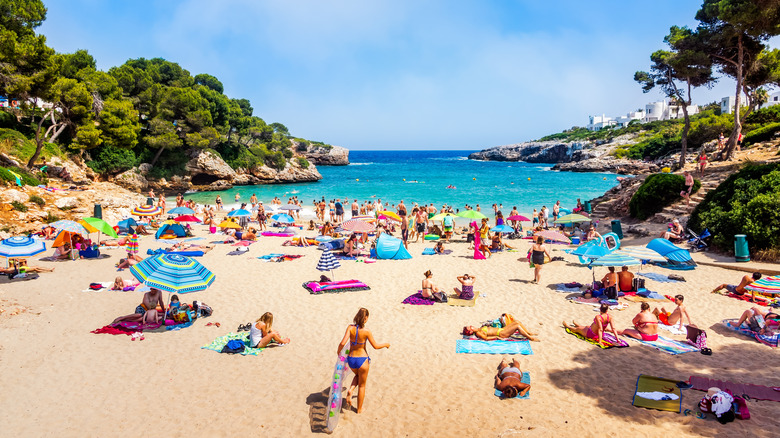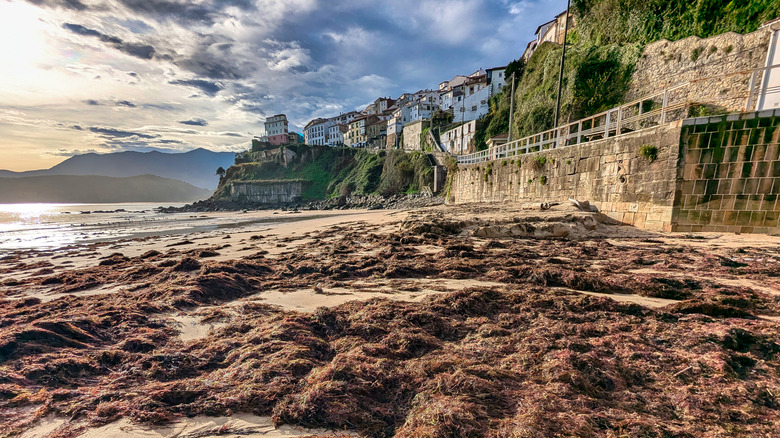Tourists Heading To Spain Should Watch Out For This Unexpected Beach Issue
What could be more idyllic than a summer escape to a colorful beachside village somewhere along the coast of Spain? But imagine you arrive at your dream destination, and the white-sand beach in that village is covered with piles of brown algae. And to make matters even worse, the piles smell like a swamp/dumpster love child. This is not a bad dream, it's reality, and it's happening all over the Spanish coast.
The brown algae — the scientific name for which is Rugulopterix okamurae — is native to the northwest Pacific Ocean but found its way into the Atlantic in the last decade, possibly by hitching a ride on a cargo ship. Ever since, it has been spreading like a weed throughout the Atlantic and Mediterranean. The ghastly plant has a horrible effect on marine ecosystems as it colonizes sea beds, where it tends to crowd out plants and repel fish that don't find it at all appetizing. But Rugulopterix okamurae doesn't stop there. It continues reproducing on the sea bed, producing a constant upward stream of plant parts that get swept away by currents and wash up on beaches. Sometimes these algae flows are so prolific that the debris that accumulates and can cover a whole beach, with mounds reaching 3 feet high — creating actual algae dunes. This doesn't bode well for sunbathing, swimming, fishing, or just being anywhere near the unsightly, smelly beach.
It's possible to clean up infested beaches, but this is a very time-consuming process, especially since it must be repeated each time there's an influx. In the city of Marbella near Spain's southern tip, for example, cleaning crews use tractors to scoop up tons of algae from beaches every morning and then haul it away in trucks. The cost of this clean up over three months was around $830,000.
Which beaches are affected and at risk
Algae infusions vary each year depending on currents and weather patterns. That said, there are several places in Spain where Rugulopterix okamurae is problematic right now — important to know if you're planning a visit, especially if you want to hang out on the beach. The hardest hit area has been the Andalusian coast, where Marbella is located. Other affected areas are northeast of Andalusia, around the cities of Murcia and Valencia. Unlike Marbella, not all cities in affected areas can afford to clean up their beaches. One of these is Tarifa at Spain's southernmost point. It's also the launching point for one of Europe's best day trips — taking a ferry across the Strait of Gibraltar to Tangier, Morocco. The algae's effect on the tourism industry in Tarifa and other affected Spanish beach towns hasn't been quantified yet, but it can't be good.
Fortunately, Rugulopterix okamurae has not yet reached the Balearic Islands, which include Menorca, Ibiza, Formentera, and Mallorca, an amazing destination for water-based adventures. But it may only be a matter of time. Last year the algae was detected as close as the Port of Barcelona, only 126 nautical miles from Alcúdia, Mallorca. Recognizing the looming threat to island economies, which are completely intertwined with tourism and the sea, marine experts are working hard to ward off an invasion. "We must act in time because we have the knowledge and we can carry out effective preventive management to avoid an invasion or, at least, minimise its impact," said Fiona Tomàs, a researcher at the IMEDEA Mediterranean Institute of Advanced Studies, per the Majorca Daily Bulletin.

